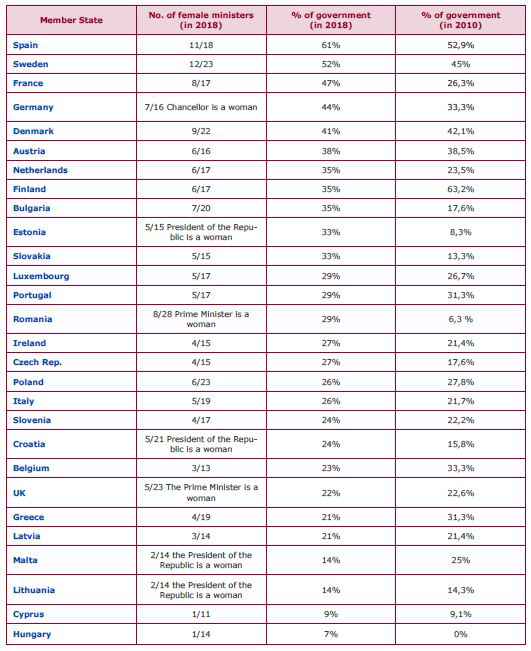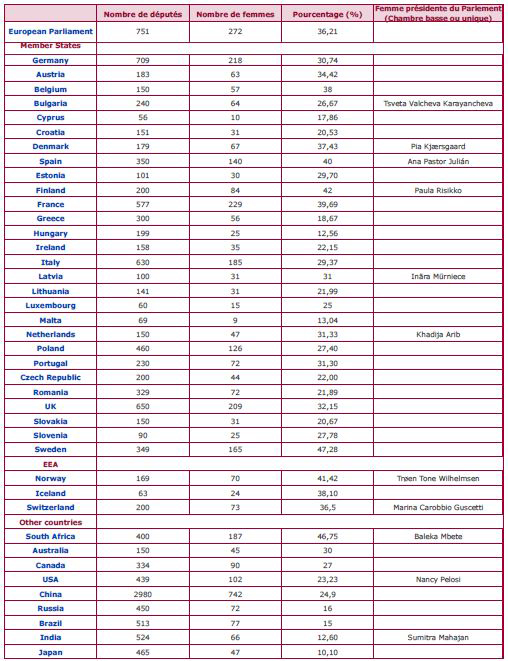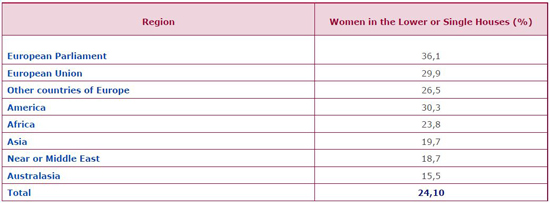Gender equality
Pascale Joannin,
Ramona Bloj
-

Available versions :
EN

Pascale Joannin
Ramona Bloj
***
European Legislative and Institutional Framework
Gender equality and the fight to counter all types of discrimination against women lies at the core of the European Union's treaties: it is included in articles 2 and 3 of the Treaty on European Union (principle of the equality between men and women), in articles 8 and 19 of the Treaty on the Functioning of the European Union, which stipulates that the Union - in all of its actions, ensures the respect of equality between men and women, the European Council and Parliament - as part of its ordinary legislative procedure can take steps in this sense, as well as in article 23 of the Charter of Fundamental Rights, notably in terms of wages and work.
Moreover, the European Parliament recently approved several resolutions on this issue. As examples we might quote that of 11th September 2018, on the prevention of and fight to counter harassment and sexual aggression in the workplace, in the public domain and in European political life, or that of 15th January 2019 on male-female parity, which calls for effective measures to be taken to guarantee equality between men and women, to improve the situation in the institutions, both from an administrative, as well as a political point of view.
Although these resolutions are not binding, they communicate the Parliament's opinion on the issue and encourage the other European institutions - the Council and the Commission - to address it and to take action. Because in this matter, as in others, everything depends on political will.
European Political Situation[1]: the situation is still not right
In the European Parliament (2014-2019), women's representation lies at 36.2% of MEPs, which is often a better score than in many Member States' national parliaments. Hence women's representation in the European Parliament is 12 points over the world average of national parliaments (24.1%) and 7 points over the European average (29.8%). However, although the number of women with a seat there has increased significantly since 1979 (16.6%)[2], we are far from achieving parity, which as a reminder is 50%! In the eight political groups that currently sit in the European Parliament only two are led by women: the GUE/NGL group, chaired by German Gabriele Zimmer (Die Linke) and the Green/EFA group, co-chaired again by a German, Ska Keller (Die Grünen). The room for improvement is indeed a reality...
In the European Office, or the executive of the Parliament, comprising the President, 14 Vice-Presidents and 5 questeurs, there are only 5 women. We are far from truly strict parity, which should however be the rule.
In the European Commission only 9 of the 28 commissioners are women, i.e. 32.1%. None have ever been president, only one is currently Vice-President out of the six positions of Vice-President, chosen at the very end of the procedure to avoid a "blacklisting" by the networks and structures, which monitor the strictly and exclusively male executives.
It is hardly better in the departments
According to the most recent data, women represent 59% of the Parliament's staff, but they are still under-represented in managerial positions. The number of women in intermediary management has only increased slightly: 15.4% of general managers, 30.4% of managers, 36.2% of unit heads in the Parliament[3]. The goal set in 2017, which aims to reach 30% of women at general manager level, 35% director level and 40% at unit head level by 2019 has therefore not been achieved.
In February 2018 the percentage of women in management posts in the European Commission totalled 36%, i.e. 11% more than at the start of J-C Juncker's mandate in November 2014. The President of the Commission promised to reach 40% by 31st October 2019. Will he succeed?
In the Member States, the civil services are largely feminised, but management and executive posts are mainly male dominated.
The situation worsens in the financial institutions. "For over a year, all of the high-ranking financial posts in the EU, which have become free in the European institutions have been awarded to men[4]. This started in February 2018 with the appointment of Spaniard Luis de Guindos as the Vice-President of the European Central Bank (ECB). He replaced Portuguese Vitor Constâncio. Then Italian Andrea Enria was appointed to head the European Banking Authority (EBA), in the place of a woman, Danièle Nouy. The Finance Ministers of the euro zone chose Irishman Philip Lane - the only candidate - to replace Peter Praet as chief economist of the ECB. Similarly, Italian Sebastiano Laviola will soon enter office on the board of the single resolution mechanism in replacement of Mauro Grande. The result of this is that there are only two women in the highest financial institution positions".
Undoubtedly this is one of the reasons why gender parity was named the "major national cause" by the President of the French Republic during his speech on 25th November 2017.
And the EU has put forward new legislation aiming to improve the balance between private and professional life of working parents and carers, as well as an action plan to eliminate the wage gap between men and women.
At world level, Europe is the women's continent
If we compare ourselves with the rest of the world, we can be happy. From a world point of view, Europe, despite the progress that still has to be made, seems almost idyllic. Europe is the women's continent.
If we aggregate data at world level[5], we note little change however. According to data from November 2018 in the world only 24.1% of MPs were women, ie an 11.3% increase with 1995.
In 29 countries, women represent fewer than 10% of MPs in the single or lower houses, of which four houses have no women. Rwanda is the country with the largest number of MPs in the world, 61.3% of the seats in the lower house.[6].
Regarding the post of head of State or government, the situation has not changed significantly (7.2% in 2017 in comparison with 6% in 2010). In Europe, 4 heads of State and three heads of government are currently women.
Although the number of women has grown in some countries, this does not necessarily mean a long-term trend. We must not confuse long-term development and the will of a specific government. The initiative for a 50/50 world by 2030 targeted by the UN Women does not really seem achievable.
However, two leaders of international organisations, those of the IMF and the World Bank (in the interim), two Europeans, French woman Christine Lagarde and Bulgarian Kristalina Georgieva, have publicly declared on several occasions that with more women in posts of responsibility, the world's affairs would be much improved.
In business, progress remains to be achieved
Throughout the world women have less access to the labour market than men.[7] The situation varies depending on the level of the country's development. The gap between men and women's activity is declining in developing and developed countries, but continues to grow in the emerging countries.
At European level women find it hard to access posts of high responsibility: only one managerial post in three is occupied by a woman, and in none of the Member States is the share of women managers over 50%. Company boards are still mainly governed by men: women only represent 6% of the CEOs, 15% of leading executives, 26% of non-executive posts.
Legislative measures are often taken to increase the number of women in businesses floated on the stock market. The result is that the number of women totals 40% for example in France. But we should not just focus on these businesses, but continue to work in PMEs, nor should we stop at the Boards, but also concentrate on other company decision-making structures (executive committees, auditing committees, wage committees, etc.)
The reasons behind this stagnation are multiple; the level of wealth and development, women's access to education, religious culture and traditions.
And yet, beyond the socio-cultural factors, the accelerator seems to lie especially in specific measures in support of women's representation: a fairer representation of the sexes is therefore and especially the result of political will.
At European level, women's under-representation can be explained by a slow and insufficient implementation of legislation. The lack of coordination between the various institutions, as well as weak awareness-raising regarding gender equality amongst executive bodies of the political parties, are contributing to this also.
Hence, for the Executive Management of the Parliament's communication department, it is recommended they include a stronger and more active gender perspective in its report on political decisions and particularly, in the preparation of the campaign for the European elections.
A demand for parity in 2019
The institutional renewal which will follow the European elections on 23rd-26th May, the formation of the new Commission and the appointment of new presidents at the European Council and the European Central Bank represent an opportunity and a risk. Indeed, the recent and modest developments in terms of gender equality resulting from political decisions, can easily be reversed by the same means.
But the political parties have almost all appointed male lead candidates (Spitzenkandidaten). Only two of them have appointed a tandem including a woman/ the European Green Party with Ska Keller and the European left with Slovenian Violeta Tomič.
We might then wonder about the probability of a woman acceding to the presidency of the European Commission in 2019. Except if we deem that the "Spitzenkandidaten" system has had its day and that, as stipulated in the treaties, the heads of State and government should appoint someone who has not been selected by the political parties, which are decidedly too masculine. Much has been said about the present European Commissioner responsible for Competition, Dane, Margrethe Vestager.
One thing that is certain is that Europe's leaders will not be able to behave as they have done in the past, notably worrying about the lack of women, whilst all the main posts have already been attributed to .... men. Both José-Manuel Barroso in his second mandate in 2009 and J-C Juncker in 2014 had to remind the heads of State and government to increase the number of female commissioners.
To avoid this, the rule should be established whereby the leaders of Europe must each submit a list of two names comprising a man and woman. It would be up to the President of the Commission to ensure that the right balance between men and women is reached. We might then hope that 13 women will be appointed commissioners out of a possible 27. And that of the six Vice-Presidents' posts there will not just be one woman (High Representative) but rather three. This would mean a true application of the treaties!
But prior to this, regarding the four presidential posts that are renewable in 2019 (Commission, Parliament, European Council, Central Bank), European leaders would do well to decide, from the very beginning of the process, that at least two women should be appointed to lead these institutions.
Do we have to remind people that the three European institutions have never had a woman president (Commission, European Council, European Central Bank)? It might perhaps be time to bring this anomaly to an end and to change this practice.
At the Central Bank, we might wonder that the Board does not have a single woman amongst its six members. Can we not reasonably foresee the appointment in the future of a strictly equal Board comprising three women? Since this may be difficult with the recent appointments, why not plan to appoint a President of the ECB in 2019?
In the European Parliament, which has already been presided over twice by women, Frenchwomen Simone Veil in 1979 and Nicole Fontaine in 1999, the parties and political groups might also be well inspired to appoint a woman. There are enough women within its fold (36%) and the last time Parliament had a female president dates back 20 years. This is far too long ago. They should also ensure that the next executive at the Parliament is more balanced between men and women.
We can hope that the next legislature will improve women's position even more in business, notably in SMEs and that it will encourage women's entrepreneurship. We must also be able to count on the Assembly in Strasbourg to establish rules that will enable better reconciliation between professional and family life. Parity might then easily become a reality.
Europe is a model for many citizens in other States in the world, it is on the leading edge of women's rights, it must continue its work. Although several initiatives have been developed over the last few years, as for example, a chapter designed for women in the Entreprenueriat 2020 action plan, the organisation of a female Business Angels network and the creation of a prize for innovative women, European legislators should commit more actively along this path.
On the eve of the renewal of the institutions political choices will be decisive to ensure that the principle of equality between men and women is not ignored or that it becomes a forgotten promise.
The courage of European leaders will be put to the test. Enabling Europe to be a globally unchallenged champion in this area is also a vital goal. There is not much point in advocating Human Rights if the first of them, women's rights, is not guaranteed.
Annex 1
Number of women in office in Europe and in the world
In the Member States of the European Union, we note an average 29.5% of women ministers of whom 7 women heads of State and government in 2018, in contrast to 25.4% in 2010.
3 women heads of government: Angela Merkel in Germany, Theresa May in the UK and Viorica Dăncilă in Romania;
4 women heads of State: Dalia Grybauskaite in Lithuania, Kolinda Grabar-Kitarović in Croatia, Kersti Kaljulaid in Estonia and Marie Louise Coleiro Preca in Malta.

In the other States of Europe:
there are two women Prime Ministers (Erna Solberg in Norway and Katrin Jakobsdottir in Iceland).
North America: 31.2% of women ministers

South America: 25.1% of ministers are women.

Africa: 18.6% of ministers are women.
There is one woman head of State (in Ethiopia, Sahle-Work Zewde) and one woman Prime Minister (in Namibia, Saara Kuugongelwa).
Southwest Asia: 10, 15% of ministers are women.
There are three women heads of State (in Singapore, Halimah Yacob; in Nepal, Bidhya Bhandari, and in Taiwan, Tsai Ing-wen) and two women Prime Ministers (in Bangladesh, Sheikh Hasina Wazed and in Myanmar, Aung San Suu Kyi)Central Asia: 8, 45% of ministers are women. There is one woman head of state (Salomé Zourabichvili, president of Georgia) and one woman head of the executive (Mehriban Aliyeva, Vice-President of Azerbaïdjan).

Australasia: 19.24% of ministers are women.
There is one woman head of State (Hilda Heine, in the Marshall Islands) and a woman Prime Minister (Jacinda Ardern in New-Zealand).
Annex 2
Development of the share of women in the European Parliament and in the National Parliaments

Annex 3
Regional Variations[8]

[1] See annexes 1 and 2.
[2] http://www.europarl.europa.eu/RegData/publications/2018/0001/P8_PUB%282018%290001_EN.pdf
[3] Date for the end of 2017.
[4] Emmanuel Berretta, Union européenne : où sont les femmes?, Le Point, 22nd February 2019
[5] Il y a des importantes variations régionales. Voir Annexe 3.
[6] http://www.unwomen.org/en/what-we-do/leadership-and-political-participation/facts-and-figures#notes
[7] http://www.ilo.org/wcmsp5/groups/public/---dgreports/---dcomm/---publ/documents/publication/wcms_619577.pdf
Publishing Director : Pascale Joannin
On the same theme
To go further
Freedom, security and justice
Jean Mafart
—
15 April 2025
Asia and the Indo-Pacific
Pierrick Bouffaron
—
8 April 2025
Democracy and citizenship
Radovan Gura
—
25 March 2025
Strategy, Security and Defence
Stéphane Beemelmans
—
18 March 2025

The Letter
Schuman
European news of the week
Unique in its genre, with its 200,000 subscribers and its editions in 6 languages (French, English, German, Spanish, Polish and Ukrainian), it has brought to you, for 15 years, a summary of European news, more needed now than ever
Versions :




